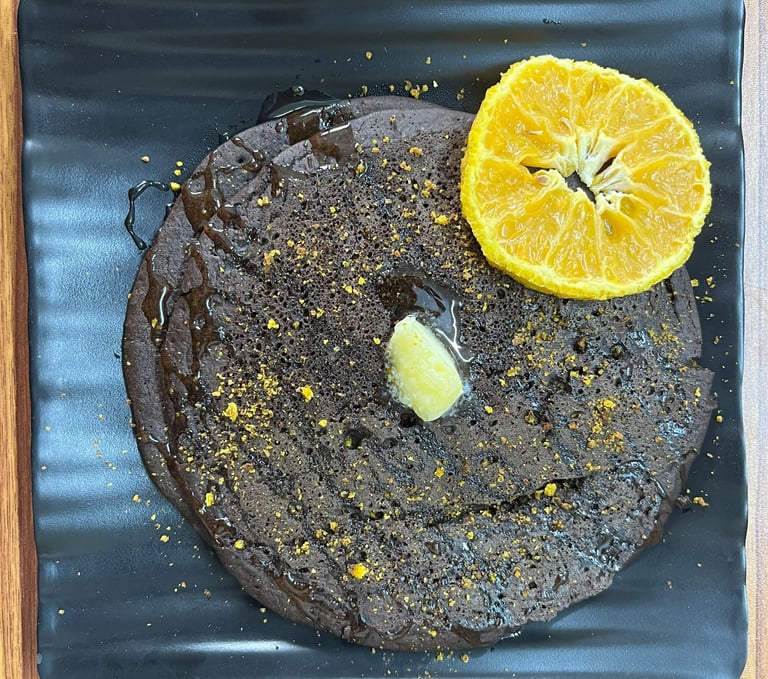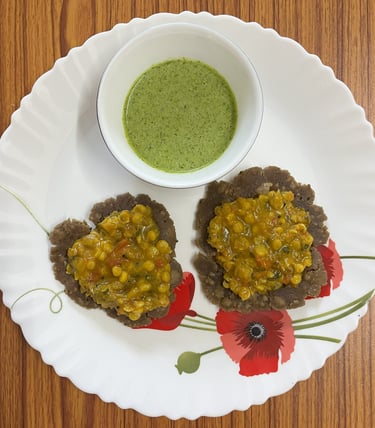Deliciously Healthy: Kodo Millet Recipes
Kodo millet pancake mix and kodo millet sindhi dal pakwan
FOOD
Twinkle Suri
11/21/20247 min read


Kodo Millet
Kodo millet, a member of the millet family, has been cultivated for centuries in various parts of Asia and Africa. It is known for its hardiness and resilience, allowing it to thrive in less-than-ideal growing conditions. This small, nutritious grain has recently gained attention in health-conscious circles, garnering a reputation as a superfood. One of the primary reasons for its rising popularity is its impressive nutritional profile. Kodo millet is gluten-free, making it an excellent choice for individuals with gluten sensitivities or those following a gluten-free diet. It also has a high fiber content. The fiber found in Kodo millet aids in maintaining gut health by promoting regular bowel movements and supporting healthy gut microbiota. Furthermore, the grain is low in calories, contributing to weight management while still providing essential nutrients.
The consumption of Kodo millet also holds promise for individuals looking to regulate their blood sugar levels. Studies suggest that the foods rich in complex carbohydrates, such as Kodo millet, can help in stabilizing blood glucose levels, which is crucial for those managing diabetes. Additionally, it contains antioxidants that combat oxidative stress and inflammation in the body, potentially reducing the risk of various health issues. Kodo millet aligns seamlessly with various dietary practices, such as veganism, emphasizing plant-based nutrition. Its adaptability in cooking makes it suitable for a myriad of recipes, from savory dishes to sweet treats. As the demand for healthy, nutrient-dense ingredients continues to rise, Kodo millet stands out as a versatile option that not only offers health benefits but also satisfies diverse culinary needs.
Pancakes
The combination of chocolate and orange is a time-honored classic that has captivated food enthusiasts for generations. The rich, deep flavors of chocolate contrast beautifully with the bright, zesty notes of orange, creating a mouthwatering balance that tantalizes the taste buds. Chocolate brings a sense of warmth and depth with its complex flavor notes, ranging from sweet to bitter. In contrast, the vibrant nature of orange introduces a distinct acidity and sweetness, which elevates the overall experience. This interplay between the richness of chocolate and the brightness of orange fosters a remarkable contrast that is both surprising and delightful, which is particularly evident in pancakes.
When enjoyed in the form of Kodo Millet chocolate and orange pancakes, the flavor synergy becomes even more evident. The fluffy, light texture of the pancakes absorbs the chocolate and orange flavors, delivering a delicious interplay with every bite. The zest from the orange not only enhances the sweetness of the chocolate but also invigorates the palate, making it an ideal breakfast option. The sensory experience of indulging in these pancakes is multifaceted: one can savor the velvety chocolate melting into the soft pancake, while the zesty orange aroma floats through the air, creating an inviting atmosphere for a delightful morning meal. As one indulges in kodo millet chocolate and orange pancakes, the harmony of these two ingredients transforms breakfast into an extraordinary culinary experience.
Ingredients:
Kodo Millet Flour - 1 cup
Flaxseed powder - 1 tbsp
Cocoa Powder - 1/4 cup
Baking Powder - 1 tsp
Jaggery Powder - 2 tbsp
Salt - a pinch
Orange -1 (for zest)
Water/ Milk - 2 to 3 tbsp (for batter formation)
Orange juice - 2 tbsp (optional; for batter formation)
Preparation:
To make the orange zest from scratch, cut the orange peels using the knife. Remember to separate out the white portion and just keep the zests (peels) intact.
Preheat the oven at 180 degree C. In the meantime, keep the peels in the baking tray lined with baking sheet/ parchment paper, with 1-2 cut slices of orange (for plating).
Dry the peels in the oven for 10 minutes on each side, or till the time they're dry completely. Cool them down and grind them in the grinder to form a fine powder. Your homemade range zest is ready!
For the pancake mix, blend together all the dry ingredients (including the zest) thoroughly without creation of any lumps. Your pancake mix is ready and can be stored in an air-tight container in the refrigerator for about 3 months.
Now to make the pancakes, slowly incorporate the wet ingredients - using either milk or water or freshly squeezed orange juice, as much as desired, to form a batter of the perfect flowable consistency. Let the pancake mix rest for about 10 minutes or so. The flaxseed powder will work as an egg replacer to provide that softness and fluffiness to the pancakes. If you want to use the egg, incorporate 1 egg (whole) after step 4, before the addition of the wet ingredients to form a smooth batter.
Now, heat the pan/ non-stick hotplate and pour the batter in the desired size. Cook until small bubbles appear on the surface, indicating it is time to flip.
Cook for about 2-3 minutes on both sides until cooked completely, achieving a fluffy and soft texture.
Serve it warm with butter and honey/ maple syrup. Garnish with some orange zest and a slice of dried orange. You can also serve it with vanilla ice cream, chopped nuts, chocolate or orange syrup or some powdered sugar dust. Enjoy!
You can also replate the cocoa powder with the protein powder of choice to make healthy protein rich pancakes. In that case, you can also try other flavor combinations such as cinnamon and walnuts or cinnamon and dried apples, coconut shavings and white chocolate or pistachios and dried rose petals.
Sindhi Dal-Pakwan
As a versatile ingredient, kodo millet can be incorporated into a wide range of dishes, including the traditional Indian Sindhi Dal Pakwan, enriching both the flavor and nutritional value. Sindhi cuisine, originating from the Sindh region of Pakistan, reflects a rich history and cultural diversity characterized by its vibrant flavors and unique culinary techniques. This cuisine is renowned for its use of spices such as cumin, coriander, and mustard seeds, which provide depth and warmth to various dishes. Traditional Sindhi meals often highlight legumes and whole grains, combined with an array of vegetables, making it a nourishing choice for families. The classic Sindhi Dal Pakwan represents this heritage beautifully, combining crispy flatbreads with a spiced lentil dish. This dish is often relished during special occasions and gatherings, showcasing the importance of communal dining in Sindhi culture. By infusing Kodo millet into this iconic recipe, we introduce a modern twist that not only honors traditional flavors but also aligns with contemporary health trends, proving that ancient recipes can adapt and thrive in today's health-focused society.
Ingredients:
For Pakwan -
Kodo Millet Flour -1 cup
Carom (Ajwain) seeds - 1/4 tbsp
Salt - as per taste
Ghee/ Oil - 1.5 to 2 tbsp
Water - 1/4 to 1/2 cup (to knead the dough)
Red Chili powder - as per taste (optional)
Oil - for frying
For Dal -
Split Chickpea Lentils (Chana dal) - 1 cup (washed and soaked for 2-3 hours)
Cumin (Jeera) seeds - 2 tsp
Asafetida - 1 tsp
Onions - 1 big (chopped)
Tomato - 1 medium sized (chopped)
Ginger- 1 inch (chopped)
Garlic - 3 to 4 cloves (chopped)
Green chilies - 1 to 2 nos. (chopped)
Turmeric powder - 1 tsp
Coriander powder - 1 tsp
Red chili powder - 1 tsp (or as per taste)
Degi Mirch Powder - 1 tsp (for color)
For added richness, you can incorporate a dash of lemon juice once the filling is prepared. As for garnishes, fresh coriander leaves and sliced green chilies provide bright colors and additional flavor.
Preparation:
In a mixing bowl, add in the Kodo millet flour along with salt, carom seeds, red chili powder and ghee/ oil. Mix thoroughly and then slowly add water (preferably warm) to make a soft dough.
After the dough formation, let it cool for about 10-15 minutes while you keep the oil for frying in the kadhai/ pan.
After the rest, make small chapatis with the dough after dividing it into small balls; firstly shaping them by hand and then slowly using the pressure with the help of the rolling pin to roll each one out.
Once the roti/ pakwan is made, poke some holes in it with the help of the fork so that it does not fluff up like a puri. This step is crucial to ensure it is crisp and flat.
When the oil is hot for frying, put the pakwan slowly in hot oil, cooking on both sides till it is crisp. Take them out on the napkins, pat them dry to remove the excess oil. You can altogether skip frying and use an air fryer or an oven to bake them, for a healthier option.
For the dal, wash the soaked dal. Put it in a pressure cooker with water, a bit of salt and turmeric and a spoonful of oil and let it pressure cook for about 4-5 whistles or till it is soft.
Now, in a separate pan, add in some oil. Put the cumin seeds and let them splutter. Next, add in the asafetida.
When the cooked smell of asafetida starts coming, add in the chopped garlic, ginger, green chilies and onions and cook them all till onions turn golden translucent.
Now, add in the spices like turmeric powder, coriander powder, red chili powder, degi mirch powder and salt. Let them all cook on medium to low flame till the spices leave their oils.
After the cooking of spices, add in the chopped tomatoes and let them all cook. This is essentially the basic "tadka/ tarka" used in Indian curries and dals for flavor enhancement.
After the tomatoes are also cooked properly, switch off the flame and put the tarka in the dal, which has been kept on low heat.
Stir and adjust the consistency of salt and water. You don't want the dal to be very thin; it should essentially be on the thicker side.
Once the dal is cooked, assemble it on the pakwan. Serve it with coriander-mint chutney or sweet red tamarind chutney on the side or top. You can also garnish it with chopped onions, chilies and coriander if you feel like. Enjoy hot!
To fully enjoy Kodo Millet Sindhi Dal Pakwan, consider pairing it with a variety of accompaniments that enhance the flavors and textures of the dish. A side of yogurt or raita offers a cooling effect that balances the spices in the dish, making it a refreshing addition. Exploring variations of the traditional Dal Pakwan recipe allows for customization based on individual preferences. While the classic preparation typically employs chana dal, other types of dal can also be experimented with. For instance, moong dal, with its lighter texture and flavor, can create a distinct twist on the classics. Alternatively, using a mixed dal approach can yield a richer taste profile and increased nutritional benefits, given the diverse nutrients present in various lentils. Another innovative approach could involve preparing a stuffed version of Pakwan, incorporating fillings like spiced potatoes or paneer, which can provide a delicious variation. Such adaptations not only cater to different dietary preferences but also invite culinary creativity, allowing anyone to enjoy this delightful dish in multiple ways.
These two delicious recipes with Kodo millet provide an innovative way to include this nutrition-packed millet into your diet. So what is stopping you? Grab your aprons and start cooking!




